Le DϢut
Le Tour de France is quite possibly one of, if not the most spectacular endurance races in the world. As ostentatious and overtly pompous as sport can be, the grandiose nature of the race is, at its heart, a pure thoroughbred marketing vehicle of media frenzy and hyperbole. The speed, the chase, the power. It is an all-encompassing multi-stringed metaphor of European political and civil struggle. Le Tour de France is not merely a bicycle race, it is an over the top sensation – about as over the top as that paragraph.
As probably the most talked about and highly financed endurance event on the planet, Le Tour attracts riders from all over the globe. Backed by ferocious multinationals all eager to capitalise on the successes of their two-wheeled advertising vehicles. Stick insects blister the roads fuelled by the roar of the crowd and financial injections summing up to sometimes six figures. For 21 days the world watches in anticipation, eager to crown its new masochistic king of the weird, wonderful and highly supplemented. Le Tour beds its roots, like most things on the continent, in a political event, a by-product of tactical politics and financial endeavor. The catalyst that spawned the very first Tour lay in the much publicised and hotly debated topic of French political culture known as The Dreyfus Affair. Without going too Nick Robinson about it, the long and short of these circumstances involved media scapegoating and racial profiling of a Jewish French Army Captain who was charged with leaking military information to the German Embassy in 1894.[1]
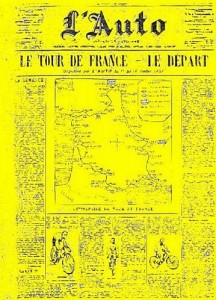
Dreyfus was however eventually found innocent, confirming what his political soigneurs new already. Eager to capitalise on anti-sematic feelings at the time, the French military orchestrated a nifty cover up and scandal plagued the populace. Uprising swept the nation south of the channel creating warring factions that either sided for, or against Drefus. The two hemispheres of opinion were emblematic of French political and social unrest in the late 1800ֳ and poor Dreyfus became the symbolic catalyst for many a late night booze driven political discussion. And so, advertisers in the popular Le VϬo newspaper, unhappy with the political stance of the then director Pierre Giffard and rising advertising costs defected from the publication and created their own Lցuto- VϬo (now known as L֩quipe). Thrust to the helm of the ship, former bicycle racer and cycling promoter Henri Desgrange was tasked with pushing Lցuto to the forefront of sporting news broadcasting. [2]
Desgrange had an alp to climb (whey!) from the outset as Le VϬoֳ control over the sporting media market looked unshakable. In an effort to win over the sporting readership of Le VϬo and fearing his job was on the line, Desgrange proposed a bicycle race to boost sales of the newspaper which at the time was a common circulation trick in the French media. The idea, though widely attributed to Desgrange was apparently thieved from a young sports journalist by the name of Geo Lefevre, whom Desgrange had taken under his wing. Desgrange took this initial idea and adapted it into a multi-stage race around the country in which punters would have to buy his newspaper to keep up with the proceedings. It was a stroke of genius as the publication soared in ratings both during and after the race eventually causing Le VϬo to fall into bankruptcy.[3]
Though not known at the time, Desgrange had created the most enticing and soon to be controversial endurance event in the world.
Le tour de France was born.
Le Premier Tour
In 1903 Desgrange and Lցuto staged the very first Tour de France, a 2428km race that originated and climaxed in the capital Paris whilst circumnavigating the cities of Nantes, Bordeaux, Toulouse, Marseille and Lyon in the process. Far from featuring the bravado and machismo of the events to follow, the first tour featured horrifically long stages (one of which 471km in length) and merely 21 out of the original 60 starters endured the race to the finale. Desgrange had actually planned the race to be more difficult but merely a handful of riders signed up.
Leading the pack from the outset and finishing with a total time of 94hr 33min and 14secs the eventual winner, Maurice Garin, dominated the race. Having won the first so convincingly, Garin took his prize money of 12,000 Francs and purchased a gas station in Lens where he saw out the rest of his years in virtual anonymity following his disqualification from the second Tour.
Classementet Maillot
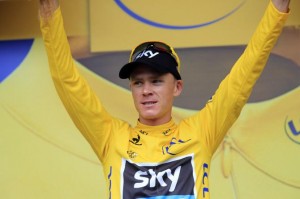
General Classification
The most sought after classification declares the overall winner of Le Tour and gained by completing the course in the lowest time possible. Since 1919 the leader at the end of each stage is provided with the Maillot Jaune (yellow jersey) to wear for the next race day. Thought to have been styled after the yellow print paper of Lցuto, the accolade of the Maillot Jaune is retroactively applied to all winners of the tour regardless of its usage at that point in time. Eddy Merckx currently holds the largest recorded number of yellow jersey wins with 96 with Bernard Hinault coming second with 75 after Lance Armstrongֳ 83 were nullified on his admission of drug use in 2012.
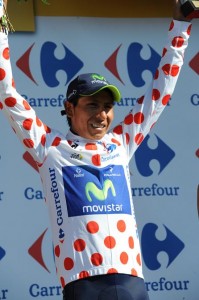
Mountains Classification
Though General Classification contenders apply a damage limitation tactic through the mountains to lose as little of their leads as possible to the climbers, a second race takes place in these stages. Those riders who specialise in the mountains aim to accumulate as many points as possible as the altitude rises. Riders are given points for varying climbs with each climb being scored depending on its perceived difficulty and length. The leader with the most amount of accumulated points at the end of Le Tour is crowned King of The Mountain and receives the much coveted Le Maillot ȠPois (the polka dot jersey) which was introduced in 1975. Richard Virenque of France holds the current record with a total of seven titles over a ten year period.
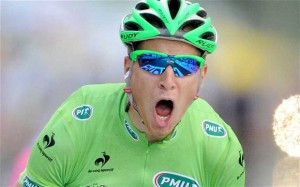
Sprinters Classification
Le Maillot Vert (green jersey), known officially as the Pointֳ Classification is awarded to riders with high finishes in stages. Though breakaway groups are common, the long flat stages typically feature athletes riding in a large mass known as the peloton which sticks together to conserve energy and speed by utilising drafting techniques.
Due to every rider in the peloton gaining the same time as the leader, breakaway groups for sprinters are commonplace. Within these groups teams will lead their sprinter out of the pack and pace them before dropping back for the last few hundred metres and allowing the sprinters to rapidly accelerate in a heated spectator driven sprint finish.
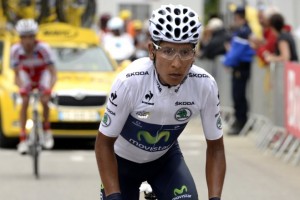
Young Rider Classification
Le Maillot Blanc (white jersey) was first introduced in 1968 and lasted until 1975 as a combination accolade for the best rider in the general classification, points classification and mountain classification. Since 1975 however, the garment has been awarded to the best rider under 26 (though the specification has changed over the years) and is scored in the same way as the Maillot Jaune with the young rider with the lowest accumulated time claiming the title. On a number of occasions the Maillot Blanc has been gifted to those who also claim the Maillot Jaune. Victors include; Laurant Fignon 1983, Jan Ullrich 1997, Alberto Contador 2007 and Andy Schleck in 2010.
Cyclistes CϬТres
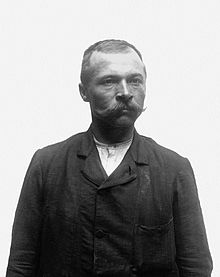
Maurice Garin
The now infamous Italian born French national Garin became the first to win Le Tour in the inaugural event in 1903. Originally from Arvier close to the French border Garin left Italy at the age of 14 with his family. Legend has it that Garinֳ transition to French life was not simple however as he allegedly had to bribe his way over the border with a round of cheese due to a lack of appropriate paperwork. Dubbed Le Petit Ramoneur or The Little Chimney Sweep by his acquaintances due to his former profession, the then 21 year old Garin began his amateur racing career in 1892 shortly after gaining French nationality.
His first outing on two wheels saw Garin finishing fifth in a 200 plus kilometre jaunt known as the Maubeuge-Hirson-Maubeuge before claiming the top spot in the Namur-Dinant-Givet race in Belgium in 1893. A tale of mystique and intrigue, the story goes that Garin turned professional merely by chance due to beating all the participants in a professionalֳ only race sometime in the early 1890ֳ. At the finale of the race, with organisers refusing to pay Garin due to him being an amateur who raced illegally, spectators allegedly whipped up a sum to pay Le Petit Ramoneur and he became fully fledged professional sometime after. Garinֳ first win as a paid racer was a 24 hour test of physical and mental endurance in Paris. Garin rode a whopping 701km in 24 hours – beating the next best by a mammoth 49km. After such a convincing first Tour, Garin was of course firm favourite for the second but with wide scale cheating and general disarray the second event was deemed a joke Рnot least because Garin himself was found catching a train midway through the race and was naturally disqualified. He retired shortly after to a humble life in the Calais town of Lens where he remained until his death in 1957.
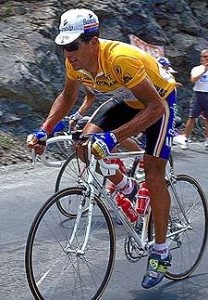
Miguel Indurain
The first rider to claim five consecutive victories on Le Tour, Indurain dominated the world of cycling from 1991-1995. A time trial specialist, the Spaniard was known for creating a lead in the individual races and holding on to the advantage throughout the mountains to lose as little time as possible. This strategy made popular by Jacques Anquetil, allowed Indurain to claim his fifth consecutive victory in 1995 a feat that remains to this day due to Lance Armstrong being stripped of his seven Tour de France titles in 2012.[4]
Big Mig was a dominating force in Le Tour not merely due to his impressive physical stature and attributes. At 6ft 2Ӡwith a resting heart rate of a reported 28bpm and a V02 max of 88 ml/kg/min his physicality was as daunting as it was perfect for the sport. Having never tested positive for performance enhancing drugs, Indurain stands as the only rider to win five tours consecutively.
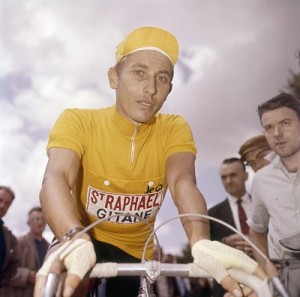
Jacques Anquetil
In 1964 Monsieur Chrono became the first to achieve five (separate) victories in the tour, claiming four consecutively from 1961-1964. A quiet reserved champion, Anquetil was known for his unique approach to
strategy. By setting impeccable leads through the TT stages, Anquetil then set himself the task of maintaining his form throughout the remainder of the race and fending off the climbing and sprinting specialists to accrue the lowest time possible – a strategy still utilised to this day. Winning the race in 1957 and then from 1961-1964 the Frenchman also took the hour record from Fausto Coppi in 1956 riding 46.159km in merely 60 minutes.[5]
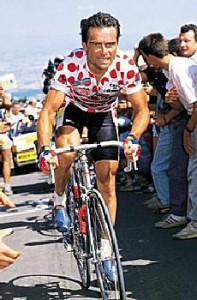
Bernard Hinault
The Badger is often hailed as second only to Eddy Merckx in terms of ultimate Tour de France victors, winning five titles 1978 Р1985 and remains the last Frenchman to win Le Tour.
Though the man himself states his moniker is merely a name given to him as a child, spectators claim that it was his casually coiffed hairbands in the early stages of his career (resembling a traditional shaving brush known as a Blaireau or badger in French) that earned him the title. Known for his aggressive leadership style and imposition during the races, Le Patron was equally feared for his commanding nature as his physical aggressiveness once claiming Ҽi>I race to win, not to please peopleӮ [6]
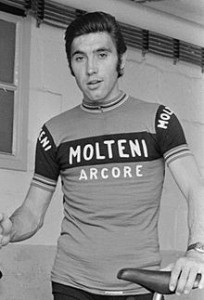
Eddie Merckx
Known as probably the greatest cyclist the sport has ever seen, Merckx was the dominant force in the late 60ֳ and early 70ֳ. As the only rider to ever take the Maillot Jaune (General Classification), Maillot Vert (Points Classification) and the Mountains Classification in 1969 (Le Maillot ȠPois not used until 1975), the Belgian won this first tour with a 17 minute 54 second lead over Roger Pingeon in second place, a feat never since matched. Merckx won Le Tour four consecutive years from 1969-1972 before being side lined in 1973 due to the safety concerns of race organisers. As Merckx was closing in on Anquetilֳ record five Tour wins, the Belgians safety was feared by race organisers who were apprehensive of attacks from French fans. He returned in 1974 to win his fifth and final tour before retiring from the race in 1977 after finishing sixth. The golden boy of cyclingֳ career was not without controversy however. Having tested positive three times for varying substances the Belgian was banned from the Giro d։talia in 1969, though protesting his innocence to this day. After retirement Merckx has become well known in the industry for his cycling company Eddy Merckx Cycles, coaching the Belgian national team through the 90ֳ and regularly being a pundit on television and in newspapers.[7]
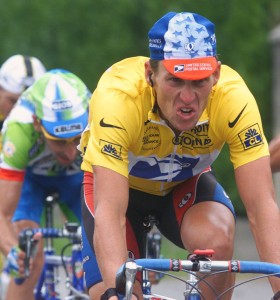
Lance Armstrong
His name has become as infamous in the world press as it has in cycling. The wonder kid who changed cycling forever, survived cancer and of course; won the tour seven consecutive times. Regardless of the drug scandals that plagued his career, few can deny Armstrongֳ tenacity and drive that fashioned the most dominant rider to ever grace the shores of France. Vehemently denying any form of drug abuse throughout his seven tour wins, Armstrongֳ name is now synonymous with EPO, blood doping and stimulants. But does this nullify his victories?
Claiming his first victory in 1999, a Tour ironically marketed as the Le Tour de Renewal due to the previous yearsՠaltercations with drugs, Armstrong held a 7 minute 37 second lead over second place Alex Zulle of Switzerland. This would be the first of seven for the young American who had miraculously survived testicular cancer in 1997. His comeback was more than remarkable, it was seen as impossible.
In the seven years that followed, the Texan denied all use of drugs, sued whistle blowers and condemned the critics. Confronting his enemies like the tarmac of the Mont Ventoux, his defence was attack. The tower would fall in 2012 when USADA (United States Anti-Doping Agency) finally found the evidence required to pin him down. Armstrong pleaded no contest to the charges and finally admitted to doping on January 4th 2013 seven years after his last victory. In an interview with Oprah Winfrey in that same month the former La Patron of the peloton claimed to lose an estimated $75 million of sponsorship in one day alone though few sympathised.[8]
Etapes
Time Trial
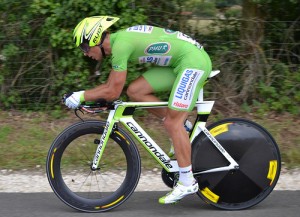
The Time Trial (TT) is a race against the clock from a fixed start with each rider competing independently of each other. Rather than the mass start of other stages, riders in the TT set off in staggered starts and are unable to draft (ride in another riders slipstream). As such, bicycles in the TT differ greatly from normal road bikes. Featuring forward facing triathlon bars and aerodynamic frames these bikes are designed to be exceptionally drag resistant. Riders typically wear aerodynamic helmets to further reduce drag and skin tight wind suits. The first stage in the tour is often (but not always) an individual Time Trial titled the prologue which dictates who wears the yellow jersey on the first mass start day of the tour.
Flat Stages/Hill Stages
Flat stages and hill stages typically sit at either side of the mountainous stages and feature large mileages across fast roads with some elevation. In these stages the peloton rides in bulk allowing cyclists to conserve 15-30% of their energy for the mountains.[9] Teams can be seen working together in a group leading their primary rider through with the lowest accumulated time possible. Breakaway groups are common throughout the closing kilometres of the stage as sprinters jostle for the win in the final few hundred metres. All riders in the main pack or large breakaway groups cross the line with the same time as the leader of pack in order to avoid mass sprints and large scale crashes.
Mountain Stages
Featuring some of the most difficult gradients in the world of cycling, the mountain stages typically include climbs such as Mont Ventoux, Alpe dֈuez and Col de Tourmalet.[10] Mountains are graded by difficulty with riders gaining more points for the difficult rides and for higher classifications. The rider over the line first each day receives Le Maillot ȠPois with the leader at the eventֳ climax being crowned King of the Mountains.
Dopage
No guide to the Tour de France would be complete without an insight into doping. Though the common misconception is that drug use is a plague of recent generations, the fact of the matter is that doping has existed since the outset of Le Tour.
Early Days
As early as the 1800ֳ athletes were known to take a variety of performance enhancing drugs including nitro-glycerine (yes, that stuff you make dynamite out of), cocaine for its stimulating effects and alcohol for pain relief. In fact the victor the very first Tour, Maurice Garin, was said to supplement his daily food intake with large quantities of red wine. Those were different times.
During World War 2, amphetamines and methamphetamines became extensively used by the allied and axis forces as a means to keep soldiers alert Рthe first chemically enhanced super soldiers. Yet in the post war cycling boom amphetamines found their way into the world of sport, not least in cycling. By the 1950ֳ amphetamines were standard issue stimulants in a cyclists race pack. Though Amphetamines come in a wide variety of form, the shared characteristic is an increase in heart rate and the release of serotonin in the brain.[11]
Serotonin is a pleasure chemical transmitted into the brain when one receives a physical sense of gratification. Common every day serotonin releases exist when one consumes sugary foods, alcoholic beverages or even post-coitus. By releasing serotonin into the brain, amphetamines mask existing pain and create a pleasurable experience for the user that is perpetuated throughout the race. Combined with alcohol and/or caffeine, amphetamines offer potent pain relief and stimulating effects on the human physiology Рa powerful performance enhancing cocktail.
Famed Italian Fausto Coppi once described to a journalist that he regularly supplemented his body with a mixture he called La Bomba which included amphetamines, opiates, cocaine, caffeine, ether, chloroform and alcohol. When asked about the incidents Coppi replied that he used the drugs ӯnly when I have toӠwhich was ӡlmost all the timeӮ
In 1967 however, cycling lost its first prodigal son to drugs when Britainֳ Tommy Simpson collapsed on the Mont Ventoux. Simpsonֳ death was largely attributed to a combination of exhaustion, dehydration and hyperthermia – and lots of amphetamines. The deadly recipe caused the British rider to collapse and die on the legendary ascent merely a kilometre from the summit of the now infamous climb. Doctors pronounced Simpson dead on arrival at nearby Avignon hospital as two bottles of empty amphetamines were found in his race jersey. [12] The British rider was and still is mourned in the cycling world as a dreamer who paid the ultimate price for his goals.
The Steroid Era
Clean cycling wouldnִ last long however as the 70ֳ quickly became the steroid generation. Though steroids had long been used for increasing muscle size and strength in sport their use in cycling was, and still is, very different. Cyclists cannot be muscle bound behemoths and as such both anabolic steroids and testosterone programs are used in low doses for rapid muscle recovery rather than increased muscularity.
Corticosteroids: Corticosteroids are the drug of choice for most riders due to the topical application and assistance in reducing inflammation from strenuous exercise. Due to their use as a treatment for saddle sores, riders could often receive backdated prescriptions from their doctors as an alibi for their use. Sneaky.
Human Growth Hormone (HGH): As the name suggests, HGH is one of the primary hormones to increase muscle size and strength in the body. This naturally occurring hormone was, and still is prevalent in the cycling world for its assistance in muscle recovery, weight loss and increasing lean muscle mass.
Testosterone: Testosterone is once more a naturally occurring hormone in the body that when used in smaller doses, promotes muscle recovery and muscular endurance. As technology improved over time however, doctors constantly looked to decrease detection of banned substances in athletes and techniques such as blood doping became more common. [13]
Blood Doping
Blood doping itself is not a drug per se, rather it is a banned procedure whereby an athlete increases the red blood cell count in the body. Blood cells are extracted from the athlete and reinstated at a later date, during which time the body naturally replenishes red blood cell stores. By restoring the extracted cells, the athlete will increase their red blood cell count which allows for a greater transportation of oxygen to the working muscles and an increased V02 max.
Erythropoietin (EPO)
EPO˷as first introduced to sport in the late 80ֳ and held a ten year tenure in Le Tour until the United States Anti-Doping Agency (USADA) finally introduced randomized testing in the year 2000 (though by all accounts this was very easy to cheat). Since the introduction of the Biological Passport in 2007 however USADA claims that EPO and other performance enhancers are on a downward spiral.
The basic premise ofʼa title=”EPO” href=”http://news.bbc.co.uk/sport1/hi/front_page/4657010.stm” target=”_blank”>EPO is that it increases the number of red blood cells in an athleteֳ system similar to blood doping. As with blood doping the larger amount of blood cells causes an increase oxygen supply that directly effects the V02 max of an athlete. The benefit ofʼa title=”EPO” href=”http://news.bbc.co.uk/sport1/hi/front_page/4657010.stm” target=”_blank”>EPO however is that this happens instantaneously rather than over a period of time. Lance Armstrongֳ former team mate Tyler Hamilton claims that he and Team US Postal Service regularly stopped along Le Tour to pick upʼa title=”EPO” href=”http://news.bbc.co.uk/sport1/hi/front_page/4657010.stm” target=”_blank”>EPO and injected on the route before depositing needles into Coca-Cola cans and crushing them.
The WADA Biological Passport
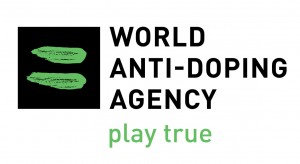
Since the World Anti-Doping Agency introduced the Biological Passport in 2007 athletes have been under far greater scrutiny with regards to their substance intake. The Biological Passport is different from traditional on the spot drug testing as it follows the correlation of an athleteֳ vitals over a period of time – thereby noting substantial changes in an athleteֳ body chemistry rather than searching for specific drugs through blood or urine tests.[14] During his now infamous interview with Oprah Winfrey in 2013, Lance Armstrong verified the claims of the Biological Passport, noting how it is now virtually impossible to dope in cycling with the new system in place.[15] In a recent interview with the Independent, 2012 Tour winner Bradley Wiggins also spoke in favour of the Biological Passport stating how Ҽi>you֤ have to be mad to do it (dope) in this day and age, maybe a bit psychopathicӼ/i>.[16] According to the UCI a number of athletes have been caught out using the procedure which apparently deterred riders in the 2013 Tour enough that none of those tested were found to have been doping (though the samples are stored for retroactive testing once technology improves).
Le Tour de France 2014
Le Tour 2014 is set to begin on the 5th July as the Grand Depart (opening stages) kicks off on the windy shores of Blighty. Starting in the West Yorkshire city of Leeds, the first stage will feature a 190km round robin of the Yorkshire Dales before settling in the city of Harrogate for the night. The following day stage two will cover 200km from York to Sheffield with the third and final stage being a 159km yomp from Cambridge to Londonֳ Trafalgar Square. The 101st edition of Le Tour is set to cover 3656km over the 21 day period including nine flat stages, six mountain stages, five hill stages and an individual time trial on the penultimate day. As per tradition, the race will climax on the Champs-Elysees in Paris. The 2014 Tour is set to be one for the climbers as five mountain stages close on mountaintop summits. The Kenyan born British rider Chris Froome is bookmakerֳ favourite in 2014 after claiming his first Tour victory in 2013. Froome will be joined at Team Sky by Sir Bradley Wiggins, the appropriately titled Ben Swift, Belarusian rider Kanstantsin Siutsou, Colombiaֳ Sergio Henao, Italyֳ Dario Cataldo, two Spanish riders David Lopez and Mikel Nieve and USA rider Danny Pate.
Finale
Le Tour de France has symbolised the very best and worst in sport for over 100 years. Though many claim that cyclingֳ golden age has long but passed, the introduction of stricter drug enforcement, retroactive testing and with the world witnessing the epic downfall of cyclingֳ former global megastar – the best should surely be yet to come. With the spotlight slowly shifting away from drug scandals and cheats, the world watches and waits to fall back in love Le Tour de France. The tarnished history of the event means that now more than ever, athletes have more to prove – they have to be supermen once more. The shift in focus from the former chemically enhanced nature of what was, essentially, a spectacle can now emphasise the pure nature and essence of what Le Tour represents. A metaphor for human achievement, a symbol of the lifelong battle with adversity, a motif for victory.
Le Tour de France may have been conceived in 1903, but only now has it truly been born.

